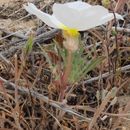pt-BR
nomes no trilho de navegação


Oenothera caespitosa, known commonly as tufted evening primrose, desert evening primrose, rock-rose evening primrose, or fragrant evening primrose, is a perennial plant of the genus Oenothera native to much of western and central North America, in habitats such as talus slopes and sandy plains.[1] It is normally night-blooming.[2]
The plant is considered good for rock gardens. There are many subtaxa, referred to as subspecies or varieties.
Oenothera caespitosa grows to 10 centimeters (4 inches) tall. It produces a rosette of lobed or toothed leaves each up to 36 centimetres (14 in) long around a woody caudex. It has no stems, with flowers and leaves growing directly from the root crown.[1] The four-petaled white flowers open at dusk and wilt the next morning, turning pink.[3] The petals measure up to 5 cm (2 in) in width and length.[1] A notch gives them a heart shape.[1]
The plant is a larval host to the white-lined sphinx moth.[4]
Oenothera caespitosa is dependent on hawkmoths, including the five-spotted hawkmoth (Manduca quinquemaculata) for pollination.[5]
Oenothera deltoides is very similar, with short stems and slightly smaller flowers.[1]
{{cite journal}}: Cite journal requires |journal= (help)  Oenothera caespitosa at dusk, Convict Lake, Mono County CA
Oenothera caespitosa at dusk, Convict Lake, Mono County CA Oenothera caespitosa, known commonly as tufted evening primrose, desert evening primrose, rock-rose evening primrose, or fragrant evening primrose, is a perennial plant of the genus Oenothera native to much of western and central North America, in habitats such as talus slopes and sandy plains. It is normally night-blooming.
The plant is considered good for rock gardens. There are many subtaxa, referred to as subspecies or varieties.
Oenothera cespitosa là một loài thực vật có hoa trong họ Anh thảo chiều. Loài này được Nutt. mô tả khoa học đầu tiên năm 1813.
Oenothera cespitosa là một loài thực vật có hoa trong họ Anh thảo chiều. Loài này được Nutt. mô tả khoa học đầu tiên năm 1813.